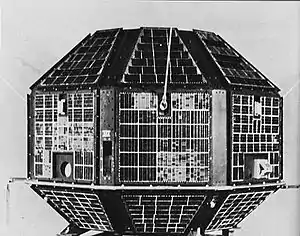INSAT-3B
INSAT-3B is an Indian communications satellite which was built by the Indian Space Research Organisation and operated by Indian National Satellite System. It's the first Geostationary satelite by India.
| Mission type | Communication |
|---|---|
| Operator | INSAT |
| COSPAR ID | 2000-016B |
| SATCAT no. | 26108 |
| Mission duration | 12 years |
| Spacecraft properties | |
| Bus | I-2K |
| Manufacturer | ISRO |
| Launch mass | 2,070 kilograms (4,560 lb) |
| Power | 1,712 watts |
| Start of mission | |
| Launch date | 21 March 2000 |
| Rocket | Ariane 5G |
| Launch site | Kourou ELA-3 |
| Contractor | Arianespace |
| Orbital parameters | |
| Reference system | Geocentric |
| Regime | Geostationary |
| Longitude | 83° East |
| Perigee altitude | 35,743 kilometres (22,210 mi)[1] |
| Apogee altitude | 35,829 kilometres (22,263 mi)[1] |
| Inclination | 0.01 degrees[1] |
| Period | 1,436.06 minutes[1] |
| Epoch | 23 April 2000[1] |
Overview
INSAT–3B is the first satellite built under INSAT–3 series of satellites to join INSAT system. It is based on the I-2000 satellite bus. This satellite primarily serves to business communication, mobile communication and developmental communication.it provides the first set to transponders for Swaran Jayanti Vidya Vikas Antariksh Upagraha Yojana (Vidya Vahini) for interactive training and developmental communication. It is 3 – axis body stabilized in orbit using momentum and reaction wheels, solar flaps, magnetic torquers and eight 10 N and eight 22 N reaction control thrusters.
Its propulsion system consists of 440 N Liquid Apogee Motor MON-3 (Mixed Oxides of Nitrogen) and MMH (MonoMethylHydrazine) for orbit raising.
Launch
Insat-3B was launched on the 128th flight of European launch vehicle, Ariane of Arianespace, on 21 March 2000, at 23:28 UTC from ELA-3 at Kourou in French Guiana along with its co-passenger, a broadcast satellite, AsiaStar, belonging to a US company, WorldSpace.
Payload
References
- McDowell, Jonathan. "SATCAT". Jonathan's Space Pages. Retrieved 3 May 2018.
- Krebs, Gunter. "Insat 3B". Gunter's Space Page. Retrieved 2009-05-02.
- "Insat 3B". Lyngsat. Retrieved 2009-05-02.
- McDowell, Jonathan (2000-03-28). "Issue 422". Jonathan's Space Report. Archived from the original on 2011-06-08. Retrieved 2009-05-02.
- "Insat 3B". TSE. Retrieved 2009-05-02.
- "Insat-3B satellite successfully launched into orbit". BBC Archive.
- "Insat-3B second orbit raising operation successfully carried out". BBC Archive.
